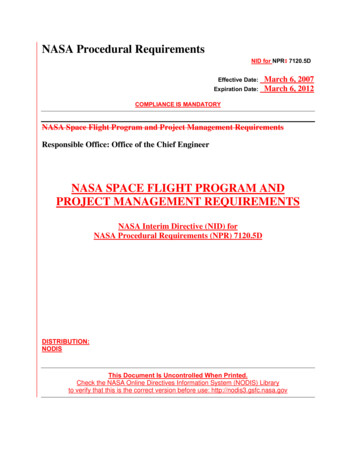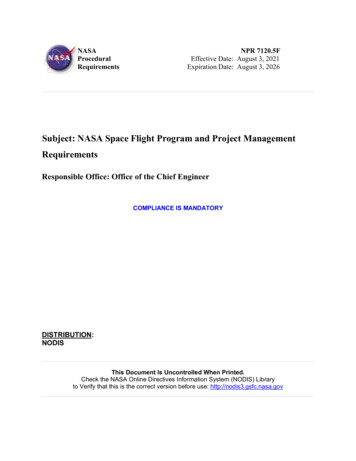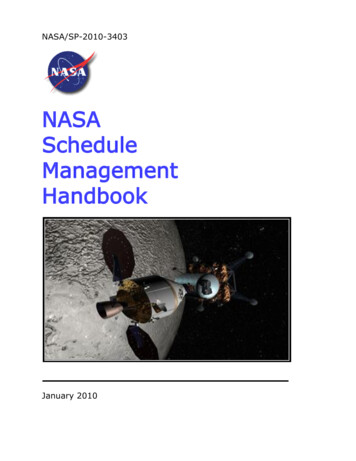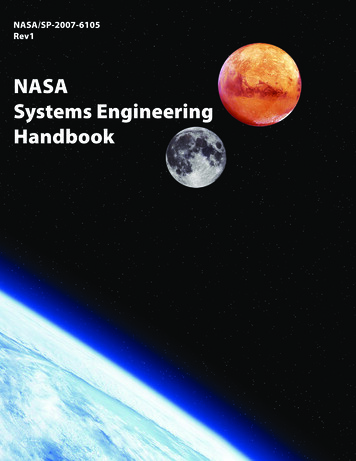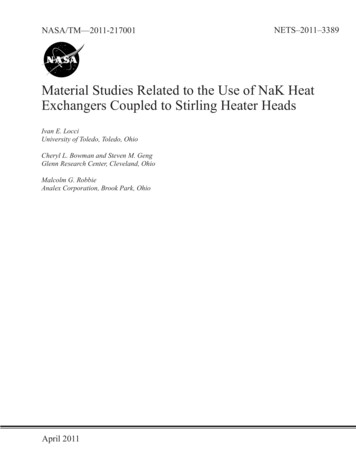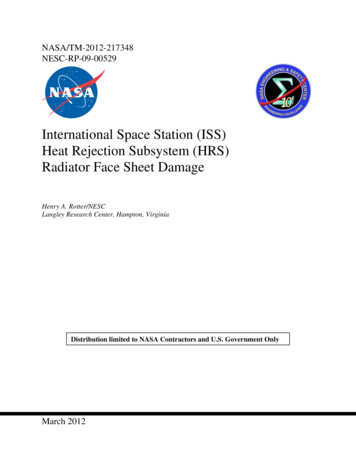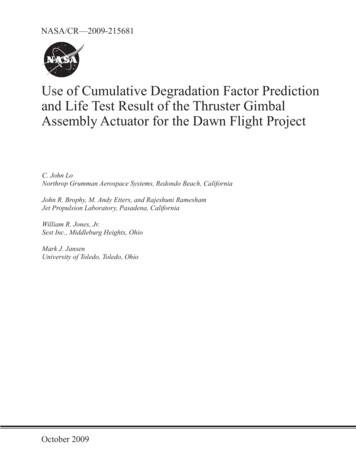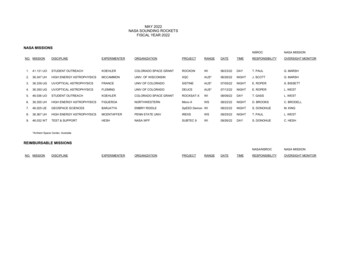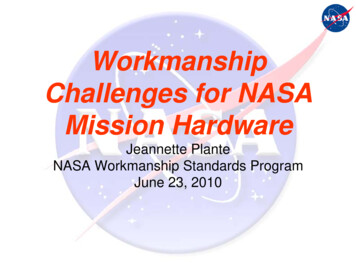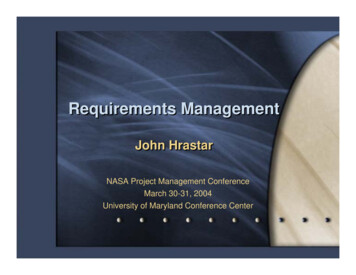
Transcription
Requirements ManagementJohn HrastarNASA Project Management ConferenceMarch 30-31, 2004University of Maryland Conference Center
IntroductionThree aspects of requirements management Requirements in the beginning Requirements in the middle What are they?How are they derived?How are they maintainedCan they be changed? Requirements in the end VerificationValidation Requirements Management 3-30-31, 20042
Introduction Dictionary definitions “ a thing demanded or obligatory ” “ a need or necessity” “ some quality or performance demanded”Strong wordsRequirements Management 3-30-31, 20043
Introduction Requirements are the single thread that goes through a projectfrom conception through build, test and flight Whole project is constructed so you can meet the requirementsBased on the need to measure a physical phenomena high levelrequirements are envisioned for a system to meet the need. Same quality or performance is demanded to be able to make thenecessary measurements Requirements are then refined, expanded, and flowed down tolower levels through an iterative process They are decomposed to the lowest levels where one person isresponsible for that system of interest.Requirements Management 3-30-31, 20044
IntroductionRequirements run through the entire Project cycle.Requirements Management 3-30-31, 20045
Introduction“Project requirements start with what the user reallyneeds ( not what the provider perceives that the userneeds) and end when those needs are satisfied”“Visualizing Project Management”Forsberg, Moog, CottermanRequirements Management 3-30-31, 20046
Customers, Users, Stakeholders, Developers User: Anyone who will work with the system. Usuallythe scientists (PI’s) looking for the measurements. Customer: Person or entity you are responding to.This includes the users, Program Office, EnterpriseStakeholder: Anyone affected by the systemincluding users, customers, developers Developers: Team that develops the system for theusersItIt isis criticalcritical thatthat allall toptop levellevel requirementsrequirements areare wellwell iteratediteratedbetweenbetween users,users, customers,customers, stakeholders,stakeholders, developersdevelopersRequirements Management 3-30-31, 20047
Failure to Satisfy CustomersNeedsRequirements Management 3-30-31, 20048
Requirements Process Iterative process between stakeholders, users, customers, anddevelopers at the beginning What needs to be done? What can be done? User must understand what can be developedWhat new technologies are required to achieve feasibility?Maintain the interaction among these groups throughout development Developers must understand user needsRe-evaluate needsClarify needsChange requirements if necessaryMust separate ‘needs” and “wants” during concept selection Requirements are agreed “needs” of the user with what can be doneAdditional “wants” (like to have) are over-specification which should bedeletedChallenging project might require technology development to high TRLsbefore “buildable” requirements can be metRequirements Management 3-30-31, 20049
Requirements ProcessRequirements Management 3-30-31, 200410
Requirements Development What are the top level requirements? What must the system do? Functional requirementsHow well must it perform? Concept of operations document to set contextPerformance requirementsHow do we record requirements? Organized into a hierarchy that flows through to lower systems of interestRequirements flow follows the Project Product Breakdown StructureLevels of requirements are shown in a document treeLevel I requirements defined in the Project Plan, also include the MissionSuccess CriteriaOrganize requirements into functional and performance Functional – what it must doPerformance – how well it must do itPerformance Requirements must be validated and verifiableRequirements Management 3-30-31, 200411
Operations Concept Development Puts the requirements in contextDescribes how the design can accomplish the missiondescribed by the objectivesDone early in the mission feasibility studiesTrade studies to developDescribes system characteristics and performance from anoperations perspectiveHelps better understand the capability and performance of thesystem within the proposed mission, use, and functionHelps scope mission development costs, schedule, constraintsProvides information on:What WhoWhyWhereWhenHowServes as a validation reference for design throughout the lifecycleRequirements Management 3-30-31, 200412
Concept and Architecture Solution SpaceLessons LearnedtenmonirnvEtnemonrivEnStandards and Best PracticesBusiness Case & User CONOPSLegaStakeholder ConstraintStakeholder ConstraintEliminated LowValue FeaturescySysSystemyLegacTechnoConcept Trade SpaceStakeholder ConstraintteUser #3mNeeds,Expectations,andUser #2 Needs, Expectations, andSolutionsSystem Requirements SolutionsValueDrivenConceptSolutionConceptandnslo #1UsergytioUser #4aitLiNeeds, Expectations,mNeeds,Expectations,miLEliminated Lowit aand Solutionsand SolutionsValue FeaturestigyBusiness Case & User CONOPSStandards and Best straintsnchTeLessons LearnedRequirements Management 3-30-31, 200413
Mission Success CriteriaFull Mission Success Criteria: Requirements that must bemet for full mission success(Cost, Schedule, Technical)Some options availableincluding descope, whichcan be exercised toimplement a successfulscience mission but onethat is less than the fullmissionMinimum Mission Success Criteria: Requirements that mustbe met for minimum missionsuccess (Cost, Schedule,Technical)Below this level, the mission is not worth continuingRequirements Management 3-30-31, 200414
Requirements Flow: Decomposition and Integration Decomposition Fabrication and assembly of the system of interestIntegration Successive combining and testing of hardware and software toprogressively demonstrate performance and compatibility ofvarious systems of interestVerification Hierarchical, functional, and physical partitioning of a system ofinterest into lower levels of systems of interest that can be assignedto a responsible managerDetermination that the system meets all specified requirementsValidation Determination that the system satisfies what the customer (user)needsRequirements Management 3-30-31, 200415
Hierarchical Relationships for Systems of InterestProjectSystem of InterestSpacecraftSpacecraftGroundGround systemsystemSystem of InterestSubsystemSubsystemSubsystemSubsystemSystem of InterestComponentComponentRequirements Management 3-30-31, 2004ComponentComponent16
Hierarchical Relationships for Systems of InterestAntennaAntenna ersFiltersRFRF SwitchSwitchDiplexersDiplexersTransponderSystem of InterestRequirements Management 3-30-31, 2004CommunicationsSystem of InterestSatelliteSystem of Interest17
Decomposition and Integration CycleIntegrateIntegrateSystemSystem ofof InterestInterestVerifyVerify && tsationIntegrateIntegrate LowerLower LevelLevelSystemSystem ofof InterestInterestIntenitioefinLowerLower LevelLevel ofof SystemSystemofof InterestInterest poscomDeIntegrateIntegrate NextNextHigherHigher LevelLevelSystemSystem ofof InterestInterestNextNext LevelLevel ofof SystemSystemofof InterestInterest RequirementsRequirementsFabricationFabrication ofofSystemSystem ofof InterestInterestRequirements Management 3-30-31, 2004Adapted from SP 610518
System Specification Allocation to Lower LeveRequirements Management 3-30-31, 200419
Managing Requirements During Development Requirements are not always static during development Legitimate new requirements might be added System design must be reviewed to assess the impactNew resources must be added; e.g., budget, weight, schedule, etc.Requirements can “creep” if one is not vigilant They can change for many different reasonsAddition of a capability that is highly desirable and seems to be“free”It is not freeContingency funds are necessary to correct problems in thedevelopment process to satisfy needed requirements They are not to be used to accommodate requirements creepThis is the only discretionary money a Project Manager hasRequirements Management 3-30-31, 200420
Managing Requirements During Development Examples STEREO – KSC clean room requirements GRO – Level I requirement on fuel load TDRSS – Major changes on a fixed-price contract EOSDIS – Missed recognition of technology changes thatcould have caused requirements changes TIMED – Missed recognition of changing environment thateventually led to requirements changesRequirements Management 3-30-31, 200421
Validation and Verification “The purpose of verification is to ensure that thesubsystems conform to what was designed andinterface with each other as expected in allrespects ” “Validation consists of ensuring that the interfacedsubsystems achieve their intended results.”“While validation is even more important thanverification, it is usually much more difficult toaccomplish” (Very clear example later.) Verification: “Is the system built right?”Validation: “Has the right system been built?”NASA Systems Engineering HandbookRequirements Management 3-30-31, 200422
Validation Validation assures the design will meet mission objectives Validation begins at the start of the project cycle Validation plan set when the user requirements baseline is setConfirmation at the control gatesValidation is a formal continuous confirmation that the productwill meet the users needs. “Will the customer smile?”Is the right system being built?Requirements vs. needsSpecification vs. needsDesign vs. needsProduct vs. needsValidation methods Focus on operational scenarios and how they are supported, I.e.the operations conceptValidate against architecture and designRequirements Management 3-30-31, 200423
Validation Stakeholders interaction is critical Keep going back to stakeholders to validate what you aredeveloping is what he/she wantsVerification program is validated to requirements Assure all requirements are verified Assure the traceability of the parent and child requirementsEnd-to-end testing is the ultimate test for bothverification and validationRequirements Management 3-30-31, 200424
Failure to ValidateRequirements Management 3-30-31, 200425
Mission Validation ptConceptMission Validation BasisValidatethese tothe e& DesignRequirementsValidate to Assure Mutual ConsistencyRequirements Management 3-30-31, 200426
Verification Make sure the team builds the system right Verify design and implementation against the requirements Proof of compliance with the specification Verification process identifies the verification item, the method(analysis, inspection, test) and review of the verification results “Test as you fly and fly as you test Need to identify anything not tested in flight configuration andascertain and mitigate risk Test planning should include environment exposure as well asrequirements for comprehensive, functional, aliveness tests, etc. End-to-end testing from the science input through the sciencedata output is the best verification and validation testRequirements Management 3-30-31, 200427
Verification Object: Ensure all functional, performance and designrequirements (from Level I through Level n) have been met Begins in Phase A, increases in Phase B with the refinement ofrequirements, cost, schedule. More detailed plans in Phase C(design). Phase D (development) includes the qualification andacceptance verification Verification methods and techniques: Test – Measured compliance with metrics Analysis – Predicted compliance with history Demonstration – Observed compliance without metrics Inspection – Compliance with drawings, documentationNASA Systems Engineering HandbookRequirements Management 3-30-31, 200428
Requirements Verification MatrixRequirements Management 3-30-31, 200429
Verification by Test Actual operation of equipment in ambient conditions or whensubject to specified environmentsFunctional testing – series of tests (elec./mech.) conducted onthe hardware and/or software at conditions less than or equal tothe design specification Comprehensive functional testDoes it perform satisfactorily?Before and after each environmental test?Environmental testing: series of tests to assure it will perform inthe flight environment VibrationAcousticThermal vacEtc.Requirements Management 3-30-31, 200430
Verification Stages Development: Formulated and implemented up to themanufacturing of qualification or flight hardware Qualification Stage: Flight (protoflight) or flight-typehardware is verified to meet functional, performance,and design requirements E.g. Breadboard testingMore severe than acceptance conditions to establish thehardware will perform in flight with sufficient marginAcceptance: Deliverable flight end item is show tomeet functional, performance, and designrequirements under flight conditionsNASA Systems Engineering HandbookRequirements Management 3-30-31, 200431
Systems Environment and Verification PhilosophyDesign RegionQualified RegionAcceptance TestRangeExpected OperationalRangeRequirements Management 3-30-31, 200432
Summary Getting requirements right at the beginning is critical becausethey run through the whole program As you proceed through the program, they must be validatedregularly with the stakeholders It is what you are putting all your effort into satisfyingIteration with the stakeholders is criticalControl must be maintained through a configuration managementprocessDon’t close your eyes to necessary changesAt the end, they must be verified and validated to assuremission objectives will be met “Is the system built right?”“Has the right system been built?”“Is the customer smiling?”Validation ExampleThe whole effort of the Project is directed toward satisfying therequirements. If done right, the Project will be successful!Requirements Management 3-30-31, 200433
Back-upRequirements Management 3-30-31, 2004
Requirements Management Process Derive requirements consistent with the Project Planregarding technical content, cost, schedule, securityand institutional requirements Perform project system engineering analysis toensure cost effective requirements are specified Collect and allocate project requirements intoimplementation elementsDocument and maintain under configuration controlproject requirements, requirements verification, andend-item spec. Note that most requirements will be derived from higher level requirementsRequirements Management 3-30-31, 200435
Requirements Accountability The purpose of requirements accountability is toensure : That all requirements have been responded to, and; Have been verified by test, inspection, demonstration andanalysisSystems Engineering is responsible for auditing theverification results and certifying that the evidencedemonstrates requirements have been achieved.The accountability extends from the beginning of theproject to the end“Visualizing Project Management”Forsberg, Moog, CottermanRequirements Management 3-30-31, 200436
Requirements Levels Science Requirements Level I requirements Based on science goals, e.g., determine the role of massive blackholes in galaxy evolutionStated in terms of various parametersFlow to science instrument requirements in terms of measuringthese parametersSets top level system requirements based on the scienceinstrument requirementsBrief document, often in the Project Plan, controlled by theEnterpriseSets derived mission level requirementsSystem specification Defines what it must doDefines how well it must do itRequirements Management 3-30-31, 200437
Requirements ProcessTechnology as a major component affecting requirementsRequirements Management 3-30-31, 200438
Requirements DevelopmentRequirements and Document Chain“Visualizing Project Management”Forsberg, Moog, CottermanRequirements Management 3-30-31, 200439
Control Gates All Control Gates must answer two questions at eachlevel of decomposition Are we building the right solution? Are we building the solution right? To answer these, the case for each level must be thecurrent one flowed down with accompanyingcriticality, risk, cost and schedule Must look up one level to assure you are building theright entity.“Visualizing Project Management”Forsberg, Moog, CottermanRequirements Management 3-30-31, 200440
Validation and VerificationVerify – “To prove the truth of ”Verification – “Evidence that established orconfirms the accuracy or truth of ”Validate – “ substantiate, confirm; to give officialsanction, confirmation or approval to ”Requirements Management 3-30-31, 200441
Verification and ValidationArchitectureArchitectureDesignDesign &&DevelopmentDevelopmentVerificationVerification && ccaattiioonn&&MissionObjectivesOpsOps ConceptConceptDevelopmentDevelopmentValidation ExampleAdapted from GSFC GPG onSystems EngineeringMutual validation of Requirements, Architecture, and OperationsRequirements Management 3-30-31, 200442
Requirements Management 3-30-31, 2004 IntroductionIntroduction Requirements are the single thread that goes through a project from conception through build, test and flight Whole project is constructed so you can meet the requirements Based on the need to measure a physical phenomena high level requirements are envisioned for a system to meet the need.
